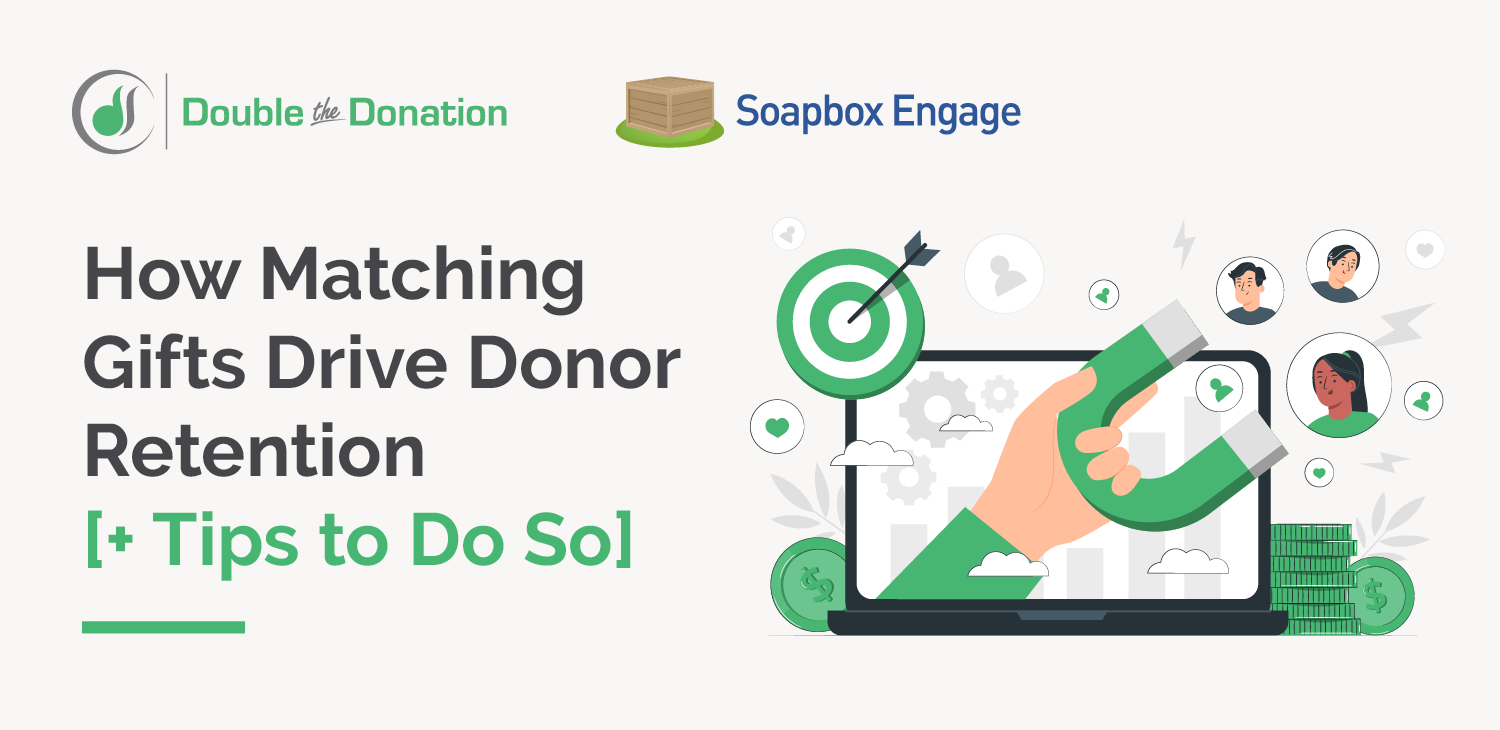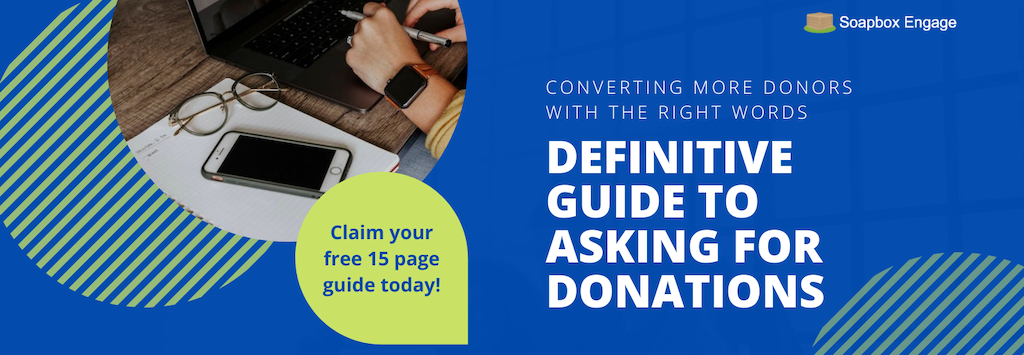
Donor retention is a critical factor for the success of any nonprofit. After all, securing repeat donations from existing supporters is significantly more cost-effective than constantly pursuing one-time gifts. Yet more often than not, new donors do not give back to the same organization the following year.
This is a significant roadblock for nonprofit fundraisers, and as a result, many teams are constantly on the lookout for innovative ways to retain support over time. One way to address this challenge is through corporate matching gifts.
Matching gift programs exist where employers agree to match employees’ charitable donations, effectively doubling the impact of each gift. These initiatives increase the amount of funding heading your way and play a crucial role in establishing connections with supporters, providing ongoing stewardship opportunities, and ultimately driving donor retention.
In this blog post, we’ll explore how effective matching gift strategies lead to high levels of donor retention—and how nonprofits like yours can leverage this idea to build stronger relationships with their donors. Plus, we’ll share some top tips and tricks to help make the most of the opportunity.
Let’s dive in!
The Impact of Matching Gifts on Donor Retention
Corporate matching gift programs and donor retention are each highly beneficial for any nonprofit. But you might be wondering how exactly the ideas intersect—and the correlation between them.
There are several ways that matching gifts positively impact donor retention. Specifically, a strategic approach to corporate matching gift programs…
- Makes your fundraising campaigns stand out from the crowd. With so many other businesses and organizations competing for your audience’s attention and support, emphasizing matching gifts in your fundraising can incentivize donors to get involved. By highlighting the impact of matched donations in your marketing and outreach materials, you can engage new supporters and retain existing ones. In fact, Double the Donation research indicates that 84% of donors are more likely to give if a match is offered, resulting in a 71% increase in donation appeal response rate.
- Keeps your nonprofit cause at top of mind post-transaction. Reminding supporters of the opportunity to double or triple their impact through a matching gift program after they contribute their initial donation offers a powerful post-donation touchpoint that can help keep your organization at the forefront of your audiences’ minds. This ongoing engagement can lead to immediate action to pursue available matches as well as increased support and loyalty over time. And ultimately, it offers a perfect segue into a well-crafted donor stewardship strategy.
- Allows donors to amplify giving impact without reaching back into their wallets. By leveraging the power of matching gifts, donors know their contributions make a more significant difference for your cause without feeling pressured to increase their financial commitment. This can be particularly helpful when engaging with donors who may be wary about their contribution’s impact on the mission. For example, it can turn “Does my $20 donation matter? Maybe I’ll just wait until I can give more.” into “My $20 gift can produce $40 worth of value—I can’t wait to give and keep giving as I increase my capacity for support!” An individual with the latter mindset is much more likely to become a long-term donor for your cause.
- Demonstrates responsible financial stewardship by your organization. By investing in corporate matching gift opportunities, your team can show donors that you take their contributions seriously—and are dedicated to making the most of their support. This can be an essential factor in building trust in your organization, leading to increased giving over time.
- Encourages donors to explore recurring gift options. One of the most effective ways to improve donor retention is to get dedicated supporters set up with recurring giving programs. Matching gift opportunities can drive participation in these initiatives, thus encouraging individuals to automate monthly or other regular giving schedules.
Ultimately, matching gift participation (and dedicated outreach regarding the programs) helps drive donor engagement levels. Donor engagement subsequently elevates supporter retention, keeping supporters involved with your organization in the long run.
Tips to Drive Donor Retention with Matching Gifts
Now that you understand the relationship between matching gifts and donor retention, we’ll share a few impactful practices for making the most of each opportunity for your cause.
We recommend that all nonprofits and other fundraising organizations implement the following tips!
1. Share a compelling message about the impact of matching gifts.
Sharing a compelling message about the impact of matching gifts can be a powerful way to increase the number of matching gifts submitted—but it can also go a long way to improve donor stewardship and retention efforts. To do so effectively, craft a message that resonates with your audience and highlights the tangible benefits of matching gifts.
Start by emphasizing the impact that matching gifts can have on your nonprofit's mission. For example, highlight a recent project or program that was made possible through matching gifts, or share the total amount of matching gift revenue collected in the last year, and explain how this support helped drive meaningful change.
Use specific examples and data to demonstrate the real-world impact of matching gifts when possible, and tie this back to your nonprofit's overall goals and objectives. Then, share this message across your donor communications, your nonprofit website (including a dedicated matching gift web page), and more to get the word out to donors, new and old alike.
2. Involve matching gifts in your donor stewardship efforts.
After an individual donates to your organization, your team likely launches a stewardship plan to keep them engaged long-term. This should incorporate a range of donor engagement tactics, personalized messaging, and more. And when you engrain matching gift opportunities in your stewardship outreach, you can continuously reap the benefits mentioned above.
Now, you might be wondering which elements of donor stewardship offer opportunities for matching gift communications. And the answer is just about everything.
Here are a few methods we recommend!
- Fundraising letters — Your organization likely sends fundraising letters (or emails, texts, etc.) to solicit support for your upcoming campaigns from existing donors. We previously mentioned that including matching gift information in donation appeals is one of the best ways to make your efforts stand out. Plus, when donors know that matching gifts are available, they’re more likely to give—and to give in larger amounts.
- Donation acknowledgments — After each gift you receive, your team likely employs some form of acknowledgment—whether it’s an automated donation receipt or a more heartfelt note or thank-you email. Drive additional support—without requesting additional funding from your donors—by highlighting matching gift opportunities in this communication!
- Dedicated matching gift follow-ups — Unfortunately, matching gift information may be overlooked in a gift acknowledgment email. That’s why we also recommend triggering separate matching gift-specific messages in the first 24 hours of a donation being made. When you know your donors’ employers, you can even provide company-specific guidelines and links to submission forms to simplify the process.
- End-of-year reviews — Does your team share a “year in review” or annual report with your donors at the conclusion of the calendar year? This can be an excellent opportunity to communicate the impact of a donor’s support on your cause overall.
It can also reiterate the benefits of matching gifts, encouraging eligible donors to take the next steps if their matches remain incomplete. For example, you might incorporate the total amount of funds collected through matching gifts so far while implementing a call to action for donors who haven’t submitted their match to do so before the end of the year. After all, the last day of a calendar year is a popular cut-off date for many companies’ matching gift request windows!
3. Communicate your gratitude throughout the matching gift process.
As donors walk through their side of the matching gift process (typically by completing a brief online form provided by their employer), it’s a good idea to share your thanks for their above-and-beyond support.
And there are a few key opportunities where we recommend doing so:
- After the donor submits their match request.
- After your organization receives the completed match.
When donors understand your appreciation for their matching gift involvement, they’ll be more likely to participate going forward. Thus, this helps drive retention for general donations and their corporate matches. Not to mention, acknowledging donor efforts is just the right thing to do!
4. Keep matching donors in mind for future fundraising initiatives.
Another thing to remember is that the vast majority of matching gift programs are not a one-time offering. Most eligible employees are informed of the maximum matching funds they can request. If a donor makes a $50 gift to your organization, but their max is set at $1,000, they’ll likely qualify for matches for additional gifts as well.
Plus, the amount available for each employee to request typically resets each year. That said, if an individual contributes $1,000 this year and reaches the cap on their annual matching funds, keep them in mind for the next year after their program restarts.
This can be an excellent way to re-engage with your supporters, remind them about the availability of matching gift programs on an ongoing basis, and keep them involved with your mission beyond the basics.
Corporate matching gifts offer an excellent opportunity for organizations to bring their revenue-generation strategies to the next level. Highlighting these programs—and their ability to amplify individual giving impact with ease—in donor communications can go a long way.
While the above findings focused on matching gifts in terms of donor retention, incorporating the practices in your overall strategy can help secure first-time donors, re-engage lapsed supporters, and more. The possibilities are endless—and you don’t want to miss out on this chance to do more for your mission!
